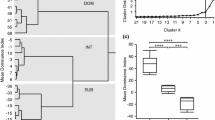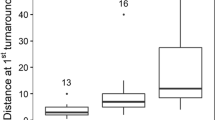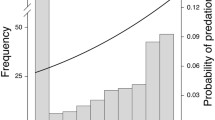Abstract
Considering the high costs of sexual reproduction (e.g., the production of males), its maintenance and predominance throughout the Animal Kingdom remain elusive. Especially the mechanisms allowing for a stable coexistence of closely related sexual and asexual species are still subject to a lively debate. Asexuals should rapidly outnumber sexuals due to higher population growth rates, unless they face some disadvantages. Here, we investigate potential differences in feeding behavior in a system of sexual (sailfin mollies, Poecilia latipinna) and coexisting gynogenetic fishes (Amazon mollies, Poecilia formosa). In two different experiments, we tested for differences in behavioral traits associated with boldness. Bold individuals take higher risks for gains in resources, so shyer individuals should be less competitive. Our study was motivated by the recent finding that P. formosa are less likely to be preyed upon by piscine predators than P. latipinna. We asked whether this result is indicative of low boldness in P. formosa. However, no differences between the two species were detectible in our behavioral experiments measuring (a) time to emerge from shelter to explore a novel environment, (b) latency time until feeding in a novel environment, and (c) recovery time until feeding restarted after a simulated predator attack. Furthermore, different boldness measures were not correlated with each other within individuals.



Similar content being viewed by others
References
Agrawal AF (2001) Sexual selection and the maintenance of sexual reproduction. Nature 411:692–695
Alberici da Barbiano L, Waller J, Gabor CR (2010) Differences in competitive efficiency between a sexual parasite and its host may explain the maintenance of a sperm-dependent vertebrate species. J Freshw Ecol 4:523–530
Aspbury AS, Gabor CR (2004) Discriminating males alter sperm production between species. Proc Natl Acad Sci 101:15970–15973
Barton NH, Charlesworth B (1998) Why sex and recombination? Science 281:1986–1990
Bell G (1982) The masterpiece of nature, the evolution and genetics of sexuality. University of California, Berkeley
Brown C, Braithwaite VA (2004) Size matters: a test of boldness in eight populations of the poeciliid Brachyraphis episcopi. Anim Behav 68:1325–1329
Brown C, Jones F, Braithwaite V (2005) In situ examination of boldness–shyness traits in the tropical poeciliid, Brachyraphis episcopi. Anim Behav 70:1003–1009
Brown C, Burgess F, Braithwaite VA (2007a) Heritable and experiential effects on boldness in a tropical poeciliid. Behav Ecol Sociobiol 62:237–243
Brown C, Jones F, Braithwaite VA (2007b) Correlation between boldness and body mass in natural populations of the poeciliid Brachyrhaphis episcopi. J Fish Biol 71:1590–1601
Case TJ, Taper ML (1986) On the coexistence and coevolution of asexual and sexual competitors. Evolution 40:366–387
Chapman BB, Morrell LJ, Krause J (2010) Unpredictability in food supply during early life influences boldness in fish. Behav Ecol 21:501–509
Dawley RM (1989) An introduction to unisexual vertebrates. In: Dawley RM, Bogart JP (eds) Evolution and ecology of unisexual vertebrates. Bulletin 466. New York State Museum, New York, pp 1–18
Dingemanse NJ, Van der Plas F, Wright J, Reale D, Schrama M, Roff DA, Van der Zee E, Barber I (2009) Individual experience and evolutionary history of predation affect expression of heritable variation in fish personality and morphology. Proc R Soc Lond B 276:1285–1293
Fischer C, Schlupp I (2008) Predation as a potential mechanism allowing asexual mollies to invade sexual mollies. Proc Okl Acad Sci 88:1–8
Foran MC, Ryan MJ (1994) Female–female competition in a unisexual/bisexual complex of mollies. Copeia 1994:504–508
Gabor CR, Ryan MJ (2001) Geographical variation in reproductive character displacement in mate choice by male sailfin mollies? Proc R Soc Lond B Biol Sci 268:1063–1070
Godin JGJ, Dugatkin LA (1996) Female mating preference for bold males in the guppy, Poecilia reticulata. Proc Natl Acad Sci USA 93:10262–10267
Gumm JM, Gabor CR (2005) Asexuals looking for sex: conflict between species and mate-quality recognition in sailfin mollies (Poecilia latipinna). Behav Ecol Sociobiol 58:558–565
Harcourt JL, Sweetman G, Johnstone RA, Manica A (2009) Personality counts: the effect of boldness on shoal choice in three-spined sticklebacks. Anim Behav 77:1501–1505
Hubbs CL, Hubbs LC (1932) Apparent parthenogenesis in nature in a form of fish of hybrid origin. Science 76:628–630
Kondrashov AS (1988) Deleterious mutations and the evolution of sexual reproduction. Nature 336:435–441
Ladle RJ (1992) Parasites and sex: catching the Red Queen. Trends Ecol Evol 7:405–408
Lively C, Lloyd D (1990) The cost of biparental sex under individual selection. Am Nat 135:489–500
Loewe L, Lamatsch DK (2008) Quantifying the threat of extinction from Muller’s ratchet in the diploid Amazon molly (Poecilia formosa). BMC Evol Biol 8:88
Magnhagen C (2007) Social influence on the correlation between behaviours in young-of-the-year perch. Behav Ecol Sociobiol 61:525–531
Maynard Smith J (1978) The evolution of sex. Cambridge University Press, Cambridge
Piyapong C, Krause J, Chapman BB, Ramnarine IW, Louca V, Croft DP (2009) Sex matters: a social context to boldness in guppies (Poecilia reticulata). Behav Ecol 21:3–8
Rasch EM, Monaco PJ, Balsano JS (1982) Cytophotometric and autoradiographic evidence for functional apomixis in a gynogenetic fish, Poecilia formosa and its related, triploid unisexuals. Histochem 73:515–533
Reale D, Reader SM, Sol D, McDougall PT, Dingemanse NJ (2007) Integrating animal temperament within ecology and evolution. Biol Rev 82:291–318
Redfield RJ (1994) Male mutation rates and the cost of sex for females. Nature 369:145–147
Riesch R, Duwe V, Herrmann N, Padur L, Ramm A, Scharnweber K, Schulte M, Schulz-Mirbach T, Ziege M, Plath M (2009) Variation along the shy–bold continuum in extremophile fishes (Poecilia mexicana, Poecilia sulphuraria). Behav Ecol Sociobiol 63:1515–1526
Riesch R, Schlupp I, Plath M (2008) Female sperm limitation in natural populations of a sexual/asexual mating complex (Poecilia latipinna, Poecilia formosa). Biol Lett 4:266–269
Robinson DM, Aspbury AS, Gabor CR (2008) Differential sperm expenditure by male sailfin mollies, Poecilia latipinna, in a unisexual–bisexual species complex and the influence of spermiation during mating. Behav Ecol Sociobiol 62:705–711
Scharnweber K, Plath M, Tobler M (2011) Feeding efficiency and food competition in coexisting sexual and asexual livebearing fishes of the genus Poecilia. Environ Biol Fish 90:197–205
Schartl M, Wilde B, Schlupp I, Parzefall J (1995) Evolutionary origin of a parthenoform, the Amazon molly Poecilia formosa, on the basis of a molecular genealogy. Evolution 49:827–835
Schlupp I (2005) The evolutionary ecology of gynogenesis. Ann Rev Ecol Evol Syst 36:399–417
Schlupp I, Plath M (2005) Male mate choice and sperm allocation in a sexual/asexual mating complex of Poecilia (Poeciliidae, Teleostei). Biol Lett 1:169–171
Schlupp I, Ryan MJ (1996) Mixed-species shoals and the maintenance of a sexual–asexual mating system in mollies. Anim Behav 52:885–890
Schlupp I, Nanda I, Döbler M, Lamatsch DK, Epplen JT, Parzefall J, Schmid M, Schartl A (1998) Dispendable and indispendable genes in an ameiotic fish, the Amazon molly Poecilia formosa. Cytogen Cell Gen 80:193–198
Sih A, Bell AM (2008) Insights for behavioral ecology from behavioral syndromes. In: Brockmann HJ, Roper T, Naguib M, Wynne-Edwards K, Barnard C, Mitani J (eds) Advances in the study of behavior, vol 38. Elsevier Academic, San Diego, pp 227–281
Sih A, Bell A, Johnson JC (2004a) Behavioral syndromes: an ecological and evolutionary overview. Trends Ecol Evol 19:372–378
Sih A, Bell AM, Johnson JC, Ziemba RE (2004b) Behavioral syndromes: an integrative overview. Quart Rev Biol 79:241–277
Stöck M, Lampert KP, Moller D, Schlupp I, Schartl M (2010) Monophyletic origin of multiple clonal lineages in an asexual fish (Poecilia formosa). Mol Ecol 19:5204–5215
Tiedemann R, Moll K, Paulus KB, Schlupp I (2005) New microsatellite loci confirm hybrid origin, parthenogenetic inheritance, and mitotic gene conversion in the gynogenetic Amazon molly (Poecilia formosa). Mol Ecol Notes 5:586–589
Tiira K, Laurila A, Peuhkuri N, Piironen J, Ranta E, Primmer CR (2003) Aggressiveness is associated with genetic diversity in landlocked salmon (Salmo salar). Mol Ecol 12:2399–2407
Tiira K, Laurila A, Enberg K, Piironen J, Aikio S, Ranta E, Primmer CR (2006) Do dominants have higher heterozygosity? Social status and genetic variation in brown trout, Salmo trutta. Behav Ecol Sociobiol 59:657–665
Tobler M, Schlupp I (2005) Parasites in sexual and asexual mollies (Poecilia, Poeciliidae, Teleostei): a case for the Red Queen? Biol Lett 1:166–168
Tobler M, Schlupp I (2008) Expanding the horizon: the Red Queen and potential alternatives. Can J Zool 86:765–773
Tobler M, Schlupp I (2010) Differential susceptibility to food stress in neonates of sexual and asexual mollies (Poecilia, Poeciliidae). Evol Ecol 24:39–47
Turner BJ (1982) The evolutionary genetics of a unisexual fish, Poecilia formosa. In: Barigozzi C (ed) Mechanisms of speciation. Alan R. Liss, New York, pp 265–305
Vainikka A, Rantala MJ, Niemelä HH, Kortet R (2011) Boldness as a consistent personality trait in the noble crayfish, Astacus astacus. Acta Ethol 14:17–25
Ward AJW, Thomas P, Hart PJB, Krause J (2004) Correlates of boldness in three-spined sticklebacks (Gasterosteus aculeatus). Behav Ecol Sociobiol 55:561–568
Webster MM, Ward AJW, Hart PJB (2009) Individual boldness affects interspecific interactions in sticklebacks. Behav Ecol Sociobiol 63:511–520
West SA, Lively CM, Read AF (1999) A pluralist approach to sex and recombination. J Evol Biol 12:1003–1012
Wilson ADM, Godin JGJ (2009) Boldness and behavioral syndromes in the bluegill sunfish, Lepomis macrochirus. Behav Ecol 20:231–237
Wilson ADM, Godin JGJ, Ward AJW (2009) Boldness and reproductive fitness correlates in the eastern mosquitofish, Gambusia holbrooki. Ethology 116:96–104
Wilson DS, Clark AB, Coleman K, Dearstyne T (1994) Shyness and boldnes in humans and other animals. Trends Ecol Evol 9:442–446
Acknowledgments
We would like to thank Kirk Winemiller (Texas A&M University) for kindly providing laboratory facilities. We also like to thank Dylan Thompson for assistance with computer-generated images to illustrate the experimental tanks. M. Ziege kindly provided the drawings of a sailfin and an Amazon molly. Financial support came from the German Academic Exchange Service (DAAD) and the German Society for Ichthyology (to K. S.), the Hermann-Willkomm Foundation (to M. P.), as well as the Swiss National Science Foundation (to M. T.). The Texas Parks and Wildlife Department kindly issued permits for collecting fish (SPR-1008-340).
Author information
Authors and Affiliations
Corresponding author
Electronic supplementary materials
Below is the link to the electronic supplementary material.
ESM 1
(DOC 109 kb)
Rights and permissions
About this article
Cite this article
Scharnweber, K., Plath, M. & Tobler, M. Examination of boldness traits in sexual and asexual mollies (Poecilia latipinna, P. formosa). acta ethol 14, 77–83 (2011). https://doi.org/10.1007/s10211-011-0097-6
Received:
Accepted:
Published:
Issue Date:
DOI: https://doi.org/10.1007/s10211-011-0097-6




